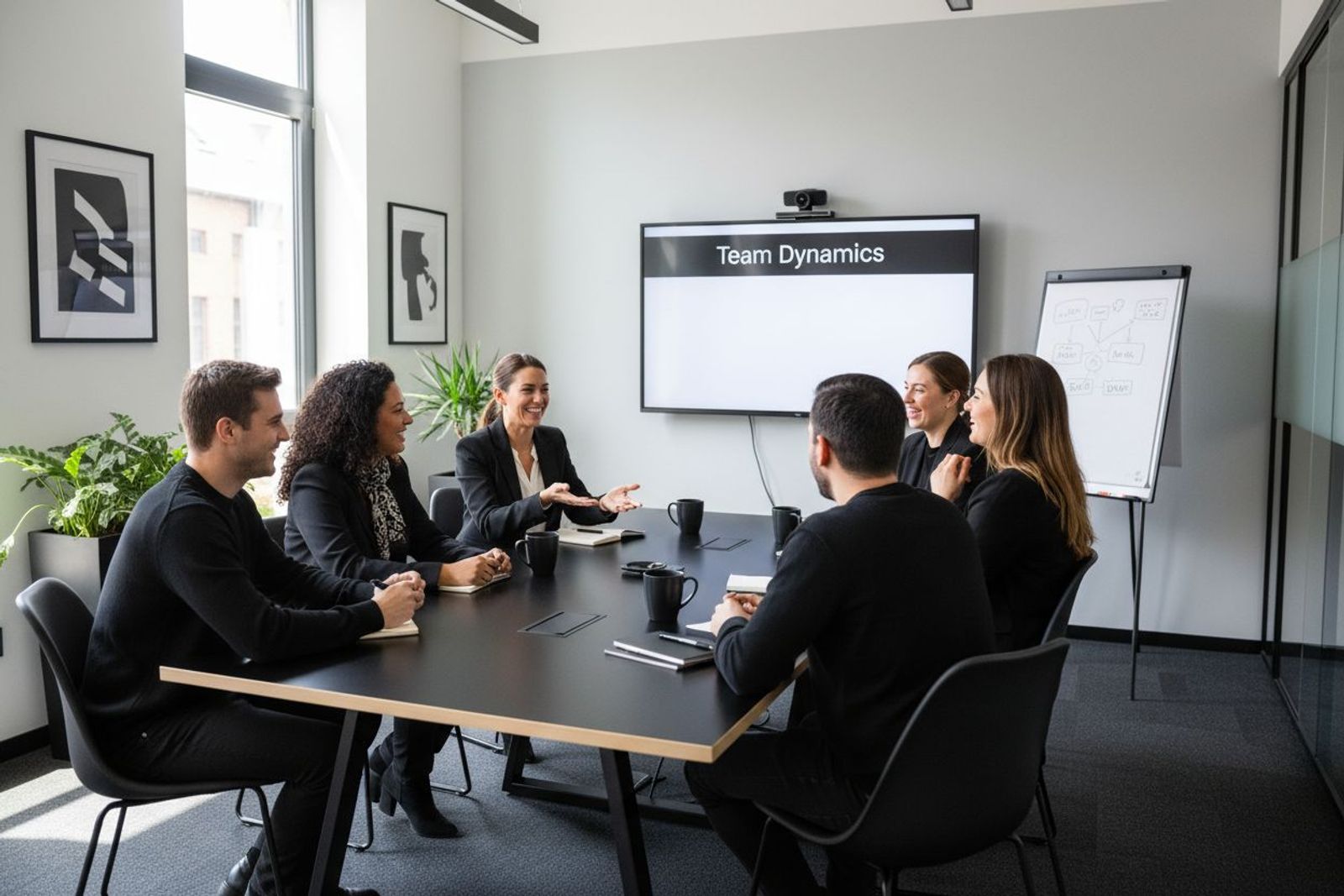Understanding Team Dynamics Explained: Key Concepts Revealed
October 12, 2025

Teamwork shapes success far beyond what most people realize. Teams with strong, healthy relationships can improve productivity by up to 25 percent according to psychological studies. That feels huge, right? But the real power of team dynamics is not in the numbers. It is in the quiet, invisible forces that determine if your crew works together or falls apart.
Table of Contents
- What Are Team Dynamics? Definition And Key Elements
- The Importance Of Team Dynamics In The Workplace
- How Team Dynamics Work: Interactions And Relationships
- Key Concepts Influencing Team Dynamics: Roles, Norms, And Culture
- Real-World Applications: Enhancing Team Performance Through Understanding Dynamics
Quick Summary
| Takeaway | Explanation |
|---|---|
| Understanding team dynamics enhances performance. | Recognizing interpersonal relationships and communication structures improves team collaboration and productivity. |
| Promote psychological safety for innovation. | A safe environment encourages creativity and open communication, leading to better problem-solving and idea generation. |
| Strong group norms foster team cohesion. | Establishing and nurturing unwritten rules can enhance trust and collaboration among team members. |
| Implement strategic interventions for improvement. | Targeted techniques, such as role clarification and communication training, can significantly enhance team dynamics and overall performance. |
| Continuous observation optimizes team dynamics. | Regular feedback and flexibility in management allow teams to adapt to evolving dynamics and maximize collaboration. |
What are Team Dynamics? Definition and Key Elements
Team dynamics represent the complex psychological and interpersonal interactions that shape how groups work together. Understanding team dynamics explained involves recognizing the intricate web of relationships, communication patterns, and behavioral influences that determine a team's overall performance and cohesion.
The Core Components of Team Dynamics
At its foundation, team dynamics encompass several critical elements that determine group effectiveness. These elements include:
- Interpersonal Relationships: The connections and interactions between team members that influence collaboration
- Communication Patterns: How information flows and is exchanged within the group
- Individual Personalities: The unique characteristics and behavioral tendencies of each team member
Understanding these components helps organizations create more functional and high-performing teams. Learn more about promoting effective teamwork through strategic team dynamics management.
The Psychological Foundations
Team dynamics are deeply rooted in psychological principles of group behavior. They emerge from complex interactions between individual motivations, group expectations, leadership styles, and organizational culture. When team members understand and navigate these dynamics effectively, they can transform potential interpersonal challenges into opportunities for enhanced collaboration and innovation.
The invisible forces driving team dynamics include emotional intelligence, trust levels, shared goals, and mutual respect.
The table below summarizes the core components that define effective team dynamics, making it easy to scan the characteristics and their impacts on group functionality.
| Component | Description | Impact on Team |
|---|---|---|
| Interpersonal Relationships | Connections and interactions between team members that influence collaboration | Boosts trust and teamwork |
| Communication Patterns | How information flows and is exchanged within the group | Reduces misunderstandings |
| Individual Personalities | Unique traits and behavioral tendencies of each team member | Shapes team roles and synergy |
| Emotional Intelligence | Ability to perceive, understand, and manage emotions within the team | Fosters empathy and conflict resolution |
| Trust Levels | Degree of confidence members have in each other | Encourages openness and reliability |
| Shared Goals | Common objectives all members work toward | Drives collective motivation |
| Mutual Respect | Valuing each team member’s contributions and perspectives | Enhances engagement and collaboration |
 These underlying factors determine whether a team will function as a cohesive unit or struggle with internal conflicts and communication breakdowns.
These underlying factors determine whether a team will function as a cohesive unit or struggle with internal conflicts and communication breakdowns.
The Importance of Team Dynamics in the Workplace
Team dynamics are not merely a theoretical concept but a critical factor that directly impacts organizational performance and employee satisfaction. Research from psychological studies demonstrates that effective team dynamics can significantly enhance workplace productivity and create a more positive work environment.
Performance and Productivity Impact
Healthy team dynamics translate into tangible business outcomes. Organizations with strong interpersonal connections and clear communication patterns experience multiple benefits:
- Enhanced Problem Solving: Teams with positive dynamics collaborate more effectively, generating innovative solutions faster
- Increased Efficiency: Smooth communication reduces misunderstandings and redundant work efforts
- Higher Employee Engagement: When team members feel connected, their motivation and commitment increase
Discover strategies for building team cohesion to unlock your team's full potential and drive organizational success.
Psychological Safety and Innovation
At the core of exceptional team dynamics lies the concept of psychological safety. This environment allows team members to take risks, share unconventional ideas, and speak up without fear of ridicule or professional repercussions. When employees feel psychologically safe, they are more likely to contribute creative solutions, challenge existing processes, and drive organizational innovation.
The quality of team dynamics determines whether a workplace becomes a collaborative ecosystem or remains a collection of isolated individuals. By investing in understanding and nurturing these dynamics, organizations can transform their workplace culture, boost employee satisfaction, and create a more resilient and adaptive workforce.
How Team Dynamics Work: Interactions and Relationships
Team dynamics emerge through complex interactions where individual behaviors, communication styles, and interpersonal relationships converge to create a unique group ecosystem. Research on team interactions reveals that these dynamics are not static but continuously evolving processes influenced by multiple psychological and social factors.
The Mechanics of Team Interactions
Interactions within teams operate through several interconnected mechanisms that shape group behavior and performance:
- Communication Patterns: How information flows between team members, including verbal and nonverbal exchanges
- Power Relationships: Informal and formal hierarchies that influence decision making
- Emotional Connections: The emotional intelligence and interpersonal bonds that enable trust and collaboration
Learn strategies for managing team dynamics to optimize your team's collaborative potential and create a more harmonious work environment.
Relationship Development and Group Norms
As team members interact repeatedly, they develop unwritten rules and expectations that become the team's cultural foundation. These group norms emerge organically through repeated interactions, establishing behavioral standards that guide individual and collective actions. Strong teams develop norms that promote mutual respect, open communication, and shared accountability, transforming individual contributions into cohesive collective performance.
Understanding these intricate relationship dynamics allows leaders and team members to intentionally shape their collaborative environment, turning potential interpersonal challenges into opportunities for enhanced teamwork and organizational success.
Key Concepts Influencing Team Dynamics: Roles, Norms, and Culture
Team dynamics are shaped by intricate interactions between individual roles, established group norms, and overarching organizational culture. Research on organizational diversity demonstrates how these interconnected elements profoundly impact team performance and collaboration.
Understanding Team Roles and Interactions
Team roles extend far beyond formal job descriptions. They encompass complex behavioral patterns and interpersonal expectations that define how individuals contribute to collective goals
This table outlines the types of team roles present in workplace teams, helping clarify the distinctions between formal, informal, and complementary roles as discussed in the article.
| Role Type | Description | Contribution to Team Dynamics |
|---|---|---|
| Formal Roles | Officially assigned responsibilities and hierarchical positions | Establish team structure and authority |
| Informal Roles | Leadership, support, and communication behaviors that emerge naturally | Encourage flexibility and adaptability |
| Complementary Roles | Interactions of individual strengths to create synergy | Maximize team performance |
- Formal Roles: Officially assigned responsibilities and hierarchical positions
- Informal Roles: Unspoken leadership, support, and communication patterns that naturally emerge
- Complementary Roles: How individual strengths interact to create synergistic team performance
Explore strategies for optimizing team performance and understanding the nuanced dynamics of collaborative work environments.
Group Norms and Cultural Foundations
Group norms represent the unwritten rules that govern team behavior and establish shared expectations. These cultural foundations develop organically through repeated interactions, creating invisible frameworks that guide decision making, communication styles, and collective attitudes. Strong teams cultivate norms that promote psychological safety, mutual respect, and collaborative problem solving.

By recognizing and intentionally shaping these dynamic elements, organizations can transform team interactions from potential sources of conflict into powerful engines of innovation and collective achievement.
Real-World Applications: Enhancing Team Performance through Understanding Dynamics
Understanding team dynamics transforms theoretical knowledge into practical organizational strategies. Research on managing team performance demonstrates how intentional interventions can significantly improve workplace collaboration and productivity.
Strategic Intervention Techniques
Organizations can enhance team performance by implementing targeted approaches that address underlying dynamics:
- Communication Skills Training: Developing active listening and clear expression techniques
- Role Clarification Workshops: Helping team members understand individual and collective responsibilities
- Conflict Resolution Frameworks: Creating structured processes for addressing interpersonal challenges
Check out our latest team building strategies to unlock your team's full collaborative potential.
Practical Performance Optimization
Effective team dynamics optimization requires a holistic approach that considers both individual capabilities and collective interactions. Leaders must create environments that encourage psychological safety, promote transparent communication, and recognize diverse contributions. By developing adaptive strategies that respond to unique team compositions, organizations can transform potential friction points into opportunities for innovation and collective growth.
The key lies in continuous observation, feedback, and flexible management approaches that recognize team dynamics as a living, evolving system rather than a static set of relationships.
Transform Team Dynamics into Lasting Collaboration
Are you facing challenges with communication issues, unclear roles, or lack of engagement within your team? As explained in this article, team dynamics are at the heart of effective workplace collaboration. Many organizations struggle with building psychological safety, promoting open communication, and developing group norms that truly stick. Without the right tools, teams might never reach their full potential.

Bring your team on a journey from theory to practice with Quizado's customizable team-building experiences. Our platform makes it simple to put concepts like team roles, communication patterns, and psychological safety into action through fun and interactive quiz games. Whether you are working remotely or in the same room, Quizado empowers you to boost engagement, foster trust, and create lasting connections. Start making your team stronger and more united today. Discover how easy it is to set up your game by visiting quizado.com now.
Frequently Asked Questions
What are team dynamics and why are they important?
Team dynamics refer to the psychological and interpersonal interactions that influence how groups work together. Understanding these dynamics is crucial because they can enhance performance, boost employee satisfaction, and foster a positive work environment.
How can I improve communication patterns within my team?
To improve communication patterns, implement regular check-ins and encourage open dialogue among team members. Consider scheduling weekly meetings to discuss progress and address any issues, ensuring everyone feels heard and engaged.
What actions can I take to foster psychological safety in my team?
To foster psychological safety, create an environment where team members feel comfortable expressing their ideas without fear of negative consequences. Encourage open feedback and acknowledge contributions openly, helping to cultivate a safe space for discussion.
How do individual roles influence team dynamics?
Individual roles significantly influence team dynamics by defining how each member contributes to collective goals. To optimize team performance, clarify roles through workshops to ensure everyone understands their responsibilities and how they complement each other.
What are some techniques for addressing conflicts within a team?
Address conflicts by establishing structured processes for conflict resolution, such as mediation sessions or open forums for discussion. Implement these techniques to resolve issues swiftly, ideally within a set timeframe of a few days to maintain team cohesion.
How can I assess the health of my team's dynamics?
You can assess team dynamics by soliciting feedback through surveys or one-on-one conversations regarding group interactions. Aim to analyze this feedback within a week to identify areas for improvement and enhance overall team performance.



